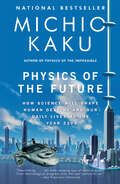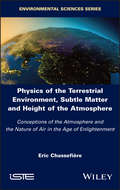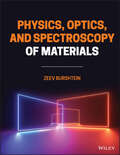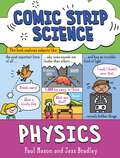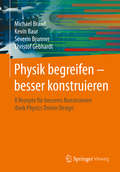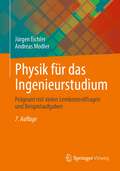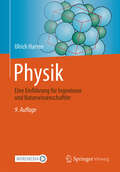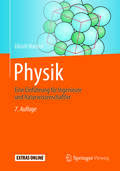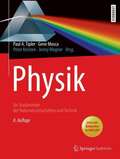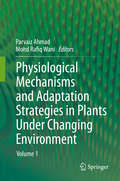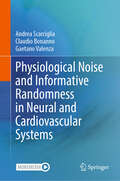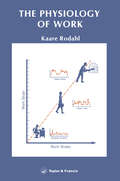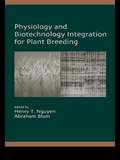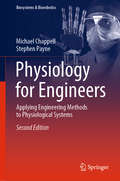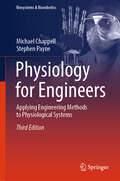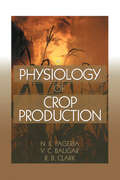- Table View
- List View
Physics of the Future: How Science Will Shape Human Destiny and Our Daily Lives by the Year 2100
by Michio KakuNATIONAL BESTSELLER • The renowned theoretical physicist and national bestselling author of The God Equation details the developments in computer technology, artificial intelligence, medicine, space travel, and more, that are poised to happen over the next century. &“Mind-bending…. [An] alternately fascinating and frightening book.&” —San Francisco ChronicleSpace elevators. Internet-enabled contact lenses. Cars that fly by floating on magnetic fields. This is the stuff of science fiction—it&’s also daily life in the year 2100.Renowned theoretical physicist Michio Kaku considers how these inventions will affect the world economy, addressing the key questions: Who will have jobs? Which nations will prosper? Kaku interviews three hundred of the world&’s top scientists—working in their labs on astonishing prototypes. He also takes into account the rigorous scientific principles that regulate how quickly, how safely, and how far technologies can advance. In Physics of the Future, Kaku forecasts a century of earthshaking advances in technology that could make even the last centuries&’ leaps and bounds seem insignificant.
Physics of the Terrestrial Environment, Subtle Matter and Height of the Atmosphere: Conceptions of the Atmosphere and the Nature of Air in the Age of Enlightenment
by Eric ChassefiereThe discovery, in the middle of the 17th century, of both the weight of air and the law governing its elasticity transformed the status of the atmosphere from that of a purely mathematical object to that of a complex and highly variable physical system.In the context of rapidly intensifying experimentation and observation, the nature of the atmosphere was therefore the subject of a host of hypotheses, which 18th century scholars tried to reconcile with a coherent physical approach. In particular, this was achieved by the conceptualization of invisible or “subtle” materials, thought to be closely linked to atmospheric stratification.Subtle matter was introduced, largely to reconcile contradictory results concerning the estimation of the height of the atmosphere. These estimations were based on different methods, mainly using the observation of meteors and the refracted and reflected light of stars.Taking as its common thread the question of the height of the atmosphere, which was omnipresent in the texts at the time, this book traces the history of the discovery of the atmosphere and the many questions it generated.
Physics, Optics, and Spectroscopy of Materials
by Zeev BurshteinPHYSICS, OPTICS, AND SPECTROSCOPY OF MATERIALS Bridges a gap that exists between optical spectroscopists and laser systems developers Physics, Optics, and Spectroscopy of Materials provides professionals and students in materials science and engineering, optics, and spectroscopy a basic understanding and tools for stimulating current research, as well as developing and implementing new laser devices in optical spectroscopy. The author—a noted expert on that subject matter—covers a wide range of topics including: effects of light and mater interaction such as light absorption, emission and scattering by atoms and molecules; energy levels in hydrogen, hydrogen-like atoms, and many electron atoms; electronic structure of molecules, classification of vibrational and rotational motions of molecules, wave propagation and oscillations in dielectric solids, light propagation in isotropic and anisotropic solids, including frequency doubling dividing and shifting, solid materials optics, and lasers. The book provides a basic overview of the laser and its comprising components. For example, the text describes methods for achieving fast Q-switching in laser cavities, and illustrates examples of several specific laser systems used in industry and scientific research. This important book: Provides a comprehensive background in material physics, optics, and spectroscopy Details examples of specific laser systems used in industry and scientific research including helium/neon laser, copper vapor laser, hydrogen-fluoride chemical laser, dye lasers, and diode lasers Presents a basic overview of the laser and its comprising components Elaborates on several important subjects in laser beams optics: divergence modes, lens transitions, and crossing of anisotropic crystals Written for research scientists and students in the fields of laser science and technology and materials optical spectroscopy, Physics, Optics, and Spectroscopy of Materials covers knowledge gaps for concepts including oscillator strength, allowed and forbidden transitions between electronic and vibrational states, Raman scattering, and group-theoretical states nomenclature.
Physics: The science of forces, energy and simple machines (Comic Strip Science #3)
by Paul MasonComic Strip Physics makes learning about the science behind forces, energy and simple machines fun! Each spread in this series features a short, funny comic strip that explains a process or aspect of science. Around the strip, diagrams and panels give further information on the topic. They are a fantastic way to engage children aged 8 plus with science.The illustrator, Jess Bradey, is winner of the 2021 Blue Peter Award for Best Non-Fiction for A Day in the Life of a Poo, Gnu and You and also writes and draws for The Phoneix Comic. Titles in the series: Biology, Chemistry, Earth and Space, Physics.
Physik begreifen – besser konstruieren: 8 Rezepte für besseres Konstruieren dank Physics Driven Design
by Michael Brand Christof Gebhardt Kevin Baur Severin BrunnerNeue Produkte zu entwerfen und funktional zu gestalten, ist eine höchst kreative und verantwortungsvolle Aufgabe. Wenn Sie die Physik hinter Ihrem Design beherrschen gelingt es Ihnen ganz selbstverständlich, besser, nämlich entlang der gewünschten Funktion, zu konstruieren.Die vorliegenden 8 Rezepte sind nicht einfach Konstruktionsvorschriften, sondern aus jahrelanger Erfahrung abgeleitete Empfehlungen, die alle einen erklärbaren physikalischen Hintergrund haben. Warum funktioniert es besser, eine Konstruktion zugdominant statt biegedominant zu gestalten? Wie verteilt man die Steifigkeiten am besten, um einen optimalen Kraftfluss zu erhalten? Was passiert an Stellen, an denen man eine Strömung umlenkt und wie kann man das mit geringsten Verlusten steuern?Die Autoren führen Sie durch die 8 Rezepte und erklären Ihnen, worauf Sie achten müssen und warum es funktioniert. Anhand konkreter Beispiele aus dem Konstruktionsalltag werden die Rezepte ausprobiert und viele Varianten durchgetestet. Bei diesem spielerischen Ausprobieren von verschiedenen Szenarien schauen Sie den Autoren über die Schulter und können erleben, wie das Verständnis um die physikalische Wirkung die Evolution des Designs steuert. Alle Beispiele wurden mit ANSYS Discovery Live aufbereitet und stehen zum Download bereit, sodass Sie selbst die Rezepte ausprobieren und auf Ihre Anwendungen übertragen können.
Physik für Ingenieure
by Ekbert Hering Rolf Martin Martin StohrerDieses Lehrbuch zeichnet sich durch klare Strukturen, bewährte Didaktik und Übersichten zur Veranschaulichung komplexer Zusammenhänge aus. Zahlreiche Abbildungen aus der Technik und Berechnungsbeispiele aus dem Arbeitsumfeld des Ingenieurs vermitteln den Praxisbezug. Übungsaufgaben und deren ausführliche Lösungen ermöglichen es, physikalische Zusammenhänge rechnerisch zu erfassen und vertiefen ihr Verständnis. Dieses erfolgreiche Standardwerk erscheint in seiner 12. Auflage. Auf den Innenseiten des Einbands finden sich nun in übersichtlicher Zusammenstellung wichtige physikalische Naturkonstanten, eine Tabelle zur Umrechnung von Energieäquivalenten sowie eine Liste öfters anzutreffender, jedoch nicht mit dem SI konformer Maßeinheiten. Die Zielgruppen Das Lehrbuch wendet sich an Studierende der Natur- und Ingenieurwissenschaften sowie an Ingenieure in der Praxis, die eine kompakte Darstellung des physikalischen Wissens schätzen.
Physik für Ingenieure
by Ekbert Hering Rolf Martin Martin StohrerDieses Lehrbuch zeichnet sich durch klare Strukturen, bewährte Didaktik und Übersichten zur Veranschaulichung komplexer Zusammenhänge aus. Zahlreiche Abbildungen aus der Technik und Berechnungsbeispiele aus dem Arbeitsumfeld eines Ingenieurs vermitteln den Praxisbezug. Übungsaufgaben und deren ausführliche Lösungen ermöglichen es, physikalische Zusammenhänge rechnerisch zu erfassen und vertiefen ihr Verständnis. Dieses erfolgreiche Standardwerk erscheint in seiner 14. Auflage.
Physik für das Ingenieurstudium: Prägnant mit vielen Lernkontrollfragen und Beispielaufgaben
by Jürgen Eichler Andreas ModlerDieses praxisnahe Lehrbuch vermittelt die physikalischen Grundlagen in den Ingenieurwissenschaften auf kompakte und prägnante Weise. Die zugrundeliegenden mathematischen Zusammenhänge werden verständlich formuliert, während viele Tabellen und Abbildungen für eine hohe Übersichtlichkeit sorgen. Unterstützt wird das Verständnis durch moderne Beispiele aus Technik und Umwelt. Die vorliegende 7. Auflage wurde unter anderem in Bezug auf die überarbeitete SI-Einheitensystematik erweitert.
Physik: Eine Einführung für Ingenieure und Naturwissenschaftler
by Ulrich HartenDie Grundlagen der Physik - kurzweilig, anschaulich und präzise.Über 400 Abbildungen und zahlreiche Beispiele aus dem Alltag fördern das Verständnis für physikalische Zusammenhänge. Die im Dialog mit Studenten erarbeitete Didaktik wird durch das ansprechende zweifarbige Layout unterstützt und erleichtert das Lernen. Über 300 Verständnisfragen und Übungsaufgaben mit Antworten im Anhang regen zu selbständiger Beschäftigung mit der Thematik an. Das Werk ist nicht nur für die Prüfungsvorbereitung hervorragend geeignet. Aufgrund des ausführlichen Sachverzeichnisses ist es auch als Nachschlagewerk zu empfehlen.Auf seiner Internetseite bietet der Autor interessante Links, Animationen und ergänzend zu den einzelnen Buchkapiteln Verständnisfragen mit kommentierten Lösungen zum Download an.In der 8. Auflage wurde das Buch aktualisiert und überarbeitet. Zudem wurden zahlreiche Videos in das Buch eingebracht.„Ein trockenes Fach"...ist das Urteil der meisten Studenten über die Physik. Mit umso mehr Vergnügen werden Sie dieses Lehrbuch zur Hand nehmen.
Physik: Eine Einführung für Ingenieure und Naturwissenschaftler
by Ulrich HartenDie Grundlagen der Physik - kurzweilig, anschaulich und präzise.Über 400 Abbildungen und zahlreiche Beispiele aus dem Alltag fördern das Verständnis für physikalische Zusammenhänge. Die im Dialog mit Studenten erarbeitete Didaktik wird durch das ansprechende zweifarbige Layout unterstützt und erleichtert das Lernen. Über 300 Verständnisfragen und Übungsaufgaben mit Antworten im Anhang regen zu selbständiger Beschäftigung mit der Thematik an. Das Werk ist nicht nur für die Prüfungsvorbereitung hervorragend geeignet. Aufgrund des ausführlichen Sachverzeichnisses ist es auch als Nachschlagewerk zu empfehlen.Auf seiner Internetseite bietet der Autor interessante Links, Animationen und ergänzend zu den einzelnen Buchkapiteln Verständnisfragen mit kommentierten Lösungen zum Download an.In der 9. Auflage wurde das Buch aktualisiert und überarbeitet. Zudem wurden zahlreiche Videos in das Buch eingebracht.„Ein trockenes Fach"...ist das Urteil der meisten Studenten über die Physik. Mit umso mehr Vergnügen werden Sie dieses Lehrbuch zur Hand nehmen.
Physik: Eine Einführung für Ingenieure und Naturwissenschaftler (Springer-Lehrbuch)
by Ulrich HartenMit Auftrieb durch die Physik In der Physik geht es wahrlich um mehr als nur hei#65533;e Luft. Mechanik, Optik, Elektrizit#65533;tslehre und Co. erschlie#65533;en sich nur wenigen Medizinstudenten intuitiv. Da kommt der Harten mit seiner verst#65533;ndlichen Sprache und den vielen Beispielen aus Alltag und Klink gerade recht, um f#65533;r Auftrieb zu sorgen. Kennt man die physikalischen Grundlagen, ist vieles in der Physiologie und sp#65533;ter in der klinischen Therapie und Diagnostik viel leichter zu verstehen - man denke nur an die Infusion oder ans R#65533;ntgen. Und f#65533;rs Verstehen hat ,,Physik f#65533;r Mediziner" jede Menge zu bieten: #65533; Physik in einfacher Sprache und mit vielen Beispielen aus Alltag und Klinik #65533; Hervorhebung der h#65533;ufigsten Pr#65533;fungsthemen #65533; Formelsammlungen, Verst#65533;ndnisfragen und #65533;bungsaufgaben am Kapitelende #65533; Spezielle Boxen f#65533;r die Vorbereitung auf das Praktikum - Zusatzmaterial auf der Autorenhomepage Die 14. Auflage wurde komplett bearbeitet, alle Themen aus dem GK sind enthalten und mehr als 430 farbige Abbildungen sorgen f#65533;r Aha-Effekte. Harten - Physik kann ganz leicht sein
Physik: für Studierende der Naturwissenschaften und Technik
by Paul A. Tipler Gene MoscaDer Tipler bietet die gesamte Physik, wie sie in den ersten Semestern im Rahmen eines Bachelorstudiums in den Natur- und Ingenieurwissenschaften gelehrt wird. Die ausführlichen und leicht nachvollziehbaren Erklärungen sowie zahlreiche Rechenbeispiele, Tipps und Methoden machen dieses Buch zu einem beliebten Begleiter im Studium. Weitere Aufgabenstellungen zur Übung am Ende jedes Kapitels in verschiedensten Schwierigkeitsgraden sowie ein Crashkurs zum Nachschlagen der benötigten mathematischen Grundlagen helfen beim Ver- und Bestehen von Vorlesungen, Übungen und Klausuren. In der neuen Auflage werden Übungsbeispiele mit einer schrittweisen, anwendungsbezogenen Einführung in das Programm MATLAB® angeboten, welches in vielen natur- und ingenieurwissenschaftlichen Fächern als Werkzeug verwendet wird.Der Tipler ist insbesondere auch für diejenigen Leserinnen und Leser geeignet, die in der Schule Physik nur als Grundkurs hatten oder sogar so früh wie möglich abgewählt haben – und nun rasch Grundlagen und physikalische Zusammenhänge aufholen müssen.Ob Physik im Haupt- oder Nebenfach - der Tipler bietet Ihnen alles in einem Buch:verständliche, nachvollziehbare Darstellung des physikalischen Inhaltsüber 480 Schritt-für-Schritt gerechnete Beispiel- und Übungsaufgabennützliche Tipps und Tricks um typische Fehler zu vermeidenZusammenfassungen mit den wichtigsten Gesetzen und Formelnanschauliche und übersichtliche Grafikendurchgehend farbiges und farbkodiertes Layout Kurzbeiträge von Forschern, die aktuelle Themen im Kontext illustrieren.Der InhaltMechanik - Schwingungen und Welle - Thermodynamik - Elektrizität und Magnetismus - Optik - Relativitätstheorie - Quantenmechanik - Atom- und Molekülphysik - Festkörperphysik - Kern- und Teilchenphysik
Physiological Bases for Maize Improvement
by Gustavo A Slafer Maria E OteguiImprove the quantity and quality of maize crops in any environment!While isolated examples of the physiological bases for genetic improvement of maize yield can be found in several papers (most of which are cited in this book), there has not, until now, been a single volume that delivers and clarifies all of the available information in this field! Today, Physiological Bases for Maize Improvement offers scientists and crop growers a thorough and concise guide to recent literature and developments about increasing the crop efficiency of corn. In Physiological Bases for Maize Improvement, international experts in the field discuss and analyze methods of effectively improving crop breeding and producing better and larger yields of corn.Physiological Bases for Maize Improvement delivers clear, thorough discussions of: improving maize grain yield potential in a cool environment improving maize grain yield potential in the tropics processes affecting maize grain yield potential in temperate conditions maize improvement for drought-limited conditions apical dominance, herbivory resistance, and competitive ability the use of simulation models for crop improvement . . . and much more! With this book, you will find ways to improve maize crops in a variety of countries and climates and understand the importance of kernel numbers and kernel growth to the overall yield. Containing current research and case studies, Physiological Bases for Maize Improvement provides you with vital strategies that will improve the quality and quantity of corn and increase plant functionality and fitness.
Physiological Mechanisms and Adaptation Strategies in Plants Under Changing Environment
by Parvaiz Ahmad Mohd Rafiq WaniAbiotic stress has a detrimental impact on the living organisms in a specific environment and constitutes a major constraint to global agricultural production. The adverse environmental conditions that plants encounter during their life cycle not only disturb their metabolic reactions, but also hamper their growth and development on cellular and whole plant levels. These conditions are of great concern, particularly for those countries whose economies primarily rely on agriculture. Under abiotic stresses, plants amalgamate multiple external stress cues to bring about a coordinated response and establish mechanisms to mitigate such stresses by triggering a cascade of events leading to enhanced tolerance. Physiological Mechanisms and Adaptation Strategies in Plants under Changing Environment, Volume 2 displays the ways by which plants utilize and integrate many common signals and subsequent pathways to cope with less favourable environmental conditions. The book also describes the use of contemporary tools for the improvement of plants under such stressed environments. Concise yet comprehensive, Physiological Mechanisms and Adaptation Strategies in Plants under Changing Environment, Volume 2 is an indispensable resource for researchers, students, environmentalists and many others in this burgeoning area of research.
Physiological Noise and Informative Randomness in Neural and Cardiovascular Systems
by Gaetano Valenza Claudio Bonanno Andrea ScarcigliaNoise, often viewed as a disturbance in biomedical signal analysis, plays a crucial and informative role in the dynamics of complex physiological systems, particularly in neurocardiovascular and neural networks. Recent developments underscore noise, or stochasticity, as fundamental to physiological processes, from information transfer in the nervous system - across scales from neurons to the brain - to cardiovascular, respiratory, motor, and sensory functions. This book offers readers a comprehensive perspective on physiological noise, redefining it not as an artifact, as traditionally viewed, but as an inherent component of physiological systems. It explores noise phenomenology within the neuro-cardiovascular system across multiple scales and presents the primary mathematical methods for estimating intrinsic noise. Building on foundational approaches, the book introduces recent noise estimation techniques and details the validation of these stochastic component estimates using synthetic data and their applications to real physiological systems. The methods ultimately position noise as a promising biomarker for differentiating between various physio-pathologic states. This book is designed for undergraduate and master&’s students, as well as PhD students and researchers in biomedical engineering and physiology. Its broad appeal stems from the subject&’s multidisciplinary nature and the structured progression of concepts, which helps readers build a strong foundation for understanding the key methods presented. Readers will be guided through a rigorous, formal exploration of essential tools, making analyses and results accessible. Illustrative figures and informal explanations of core concepts are included to enhance intuitive understanding.
Physiological Perspectives on Food Safety: Exploring the Intersection of Health and Nutrition
by Ayan Chatterjee Tanmay Sarkar Ahmed HamadAs food safety concerns become increasingly prevalent, understanding the physiological implications of foodborne pathogens, contaminants, and additives is essential for safeguarding public health. Physiological Perspectives on Food Safety: Exploring the Intersection of Health and Nutrition is a groundbreaking exploration that illuminates the dynamic relationship between food safety and human physiology. This work delves deep into the physiological mechanisms underlying the safety of the foods we consume, offering invaluable insights into how our bodies interact with and respond to the foods we eat. Bridging the gap between the fields of food science and human physiology, Physiological Perspectives on Food Safety: Exploring the Intersection of Health and Nutrition synthesizes cutting-edge research to provide a holistic understanding of the complex interactions between food safety and human health. By exploring topics such as digestive physiology, immune function, metabolic health, and neurological effects, this work sheds light on how food safety practices can impact physiological processes at every stage of life. Through its rigorous analysis, practical insights, and forward-thinking approach, Physiological Perspectives on Food Safety promises to be an indispensable resource for anyone seeking to deepen their understanding of the physiological underpinnings of food safety and its implications for human health and nutrition. It will serve as a vital resource for researchers, healthcare professionals, policymakers, and beyond.
Physiological Processes in Plants Under Low Temperature Stress
by A. BhattacharyaThis book is a collection of comprehensive reviewed chapters covering major physiological aspects, both production as well as biochemical aspects, of a plant under low temperature stress. Low temperature stress has been dealt in two parts, first between 10 to 00 C and secondly between 0 to -400 C. This book highlights the physiological aspects of plants under low temperature stress and explains the various adaptive measures plants undergo to tolerate low temperature stress. Essential information is provided on germination, growth and development, dry matter accumulation, partitioning and final yield of a crop plant. As physiology deals with morphological and biochemical aspect of all the basic processes, therefore an in depth understanding the major physiological issues in plants under high temperature will help plant breeders to tailor different crop plants with desirable physiological traits to do better under higher temperature. The present book is intended to cover the effects of low temperature stress on the various physiological aspects in plants. Not only in production physiology, this book also deals with major biochemical processes, like photosynthesis, nitrogen and lipid metabolism, mineral nutrition and plant growth hormones. Efforts have been made deal with different measures to mitigate the effects of low temperature stress on plants. This book will be an asset for post graduate students, faculty members, researchers engaged in not only in physiological studies but also agronomy, plant breeding and like subjects. In depth analysis of the major physiological processes in plants under low temperature stress that are presented in this book will help plant breeders for tailoring crops for desirable physiological traits needed to survive and to give better economic return under the threats of low temperature stress. This book is also helpful for policy planners and industries engaged in agribusiness in short term as well as long term gain.
Physiological Responses of Plants to Attack
by Dale WaltersDespite the research effort put into controlling pathogens, pests and parasitic plants, crop losses are still a regular feature of agriculture worldwide. This makes it important to manage the crop appropriately in order to maximise yield. Understanding the relationship between the occurrence and severity of attack, and the resulting yield loss, is an important step towards improved crop protection. Linked to this, is the need to better understand the mechanisms responsible for reductions in growth and yield in affected crops. Physiological Responses of Plants to Attack is unique because it deals with the effects of different attackers – pathogens, herbivores, and parasitic plants, on host processes involved in growth, reproduction, and yield. Coverage includes effects on photosynthesis, partitioning of carbohydrates, water and nutrient relations, and changes in plant growth hormones. Far from being simply a consequence of attack, the alterations in primary metabolism reflect a more dynamic and complex interaction between plant and attacker, sometimes involving re-programming of plant metabolism by the attacker. Physiological Responses of Plants to Attack is written and designed for use by senior undergraduates and postgraduates studying agricultural sciences, applied entomology, crop protection, plant pathology and plant sciences. Biological and agricultural research scientists in the agrochemical and crop protection industries, and in academia, will find much of use in this book. All libraries in universities and research establishments where biological and agricultural sciences are studied and taught should have copies of this exciting book on their shelves
Physiological, Molecular, and Genetic Perspectives of Wheat Improvement
by Shabir H. Wani Gyanendra Pratap Singh Amita MohanWorld population is growing at an alarming rate and may exceed 9.7 billion by 2050, whereas agricultural productivity has been negatively affected due to yield limiting factors such as biotic and abiotic stresses as a result of global climate change. Wheat is a staple crop for ~20% of the world population and its yield needs be augmented correspondingly in order to satisfy the demands of our increasing world population. “Green revolution”, the introduction of semi-dwarf, high yielding wheat varieties along with improved agronomic management practices, gave rise to a substantial increase in wheat production and self-sufficiency in developing countries that include Mexico, India and other south Asian countries. Since the late 1980’s, however, wheat yield is at a standoff with little fluctuation. The current trend is thus insufficient to meet the demands of an increasing world population. Therefore, while conventional breeding has had a great impact on wheat yield, with climate change becoming a reality, newer molecular breeding and management tools are needed to meet the goal of improving wheat yield for the future. With the advance in our understanding of the wheat genome and more importantly, the role of environmental interactions on productivity, the idea of genomic selection has been proposed to select for multi-genic quantitative traits early in the breeding cycle. Accordingly genomic selection may remodel wheat breeding with gain that is predicted to be 3 to 5 times that of crossbreeding. Phenomics (high-throughput phenotyping) is another fairly recent advancement using contemporary sensors for wheat germplasm screening and as a selection tool. Lastly, CRISPR/Cas9 ribonucleoprotein mediated genome editing technology has been successfully utilized for efficient and specific genome editing of hexaploid bread wheat. In summary, there has been exciting progresses in the development of non-GM wheat plants resistant to biotic and abiotic stress and/or wheat with improved nutritional quality. We believe it is important to highlight these novel research accomplishments for a broader audience, with the hope that our readers will ultimately adopt these powerful technologies for crops improvement in order to meet the demands of an expanding world population.
Physiology Of Work
by Kaare RodahlThis text focuses on the applied physiology of work in modern industry. After covering the biological background to work physiology and its relationship to work psychology and occupational medicine it goes on to explore the problems encountered via case studies. Rodhal describes methods for assessment of individual work capacities and workloads, and evaluation of working environments. Further chapters highlight: mental and emotional stresses, including case studies from management and air-traffic controllers; industrial heat and cold stress, with studies of polar and sea-going workers; and problems encountered in polluted atmospheres.
Physiology and Biotechnology Integration for Plant Breeding (Books In Soils, Plants, And The Environment Ser. #Vol. 100)
by Abraham Blum Henry T. Nguyen� Global demand for wheat, rice, corn, and other essential grains is expected to steadily rise over the next twenty years. Meeting this demand by increasing production through increased land use is not very likely; and while better crop management may make a marginal difference, most agriculture experts agree that this anticipated deficit must be m
Physiology for Engineers
by Stephen Payne Michael ChappellThis book provides an introduction to qualitative and quantitative aspects of human physiology. It looks at biological and physiological processes and phenomena, including a selection of mathematical models, showing how physiological problems can be mathematically formulated and studied. It also illustrates how a wide range of engineering and physics topics, including electronics, fluid dynamics, solid mechanics and control theory can be used to describe and understand physiological processes and systems. Throughout the text there are introductions to measuring and quantifying physiological processes using both signal and imaging technologies. Physiology for Engineers describes the basic structure and models of cellular systems, the structure and function of the cardiovascular system, the electrical and mechanical activity of the heart and provides an overview of the structure and function of the respiratory and nervous systems. It also includes an introduction to the basic concepts and applications of reaction kinetics, pharmacokinetic modelling and tracer kinetics. It is of interest to final year biomedical engineering undergraduates and graduate students alike, as well as to practising engineers new to the fields of bioengineering or medical physics.
Physiology for Engineers: Applying Engineering Methods to Physiological Systems (Biosystems & Biorobotics #24)
by Stephen Payne Michael ChappellThis book provides an introduction to qualitative and quantitative aspects of human physiology. It examines biological and physiological processes and phenomena, including a selection of mathematical models, showing how physiological problems can be mathematically formulated and studied. It also illustrates how a wide range of engineering and physics topics, such as electronics, fluid dynamics, solid mechanics and control theory can be used to describe and understand physiological processes and systems. Throughout the text, there are introductions to measuring and quantifying physiological processes using both signaling and imaging technologies. This new edition includes updated material on pathophysiology, metabolism and the TCA cycle, as well as more advanced worked examples. This book describes the basic structure and models of cellular systems, the structure and function of the cardiovascular system, and the electrical and mechanical activity of the heart, and provides an overview of the structure and function of the respiratory and nervous systems. It also includes an introduction to the basic concepts and applications of reaction kinetics, pharmacokinetic modelling and tracer kinetics. It appeals to final year biomedical engineering undergraduates and graduates alike, as well as to practising engineers new to the fields of bioengineering or medical physics.
Physiology for Engineers: Applying Engineering Methods to Physiological Systems (Biosystems & Biorobotics #33)
by Stephen Payne Michael ChappellThis book introduces both qualitative and quantitative aspects of human physiology through language and concepts familiar to engineers and other physical scientists. It looks at biological and physiological processes and phenomena, including a selection of mathematical models, showing how physiological problems can be mathematically formulated and studied. It also illustrates how a wide range of engineering and physics topics, including electronics, fluid dynamics, solid mechanics and control theory can be used to describe and understand physiological processes and systems. Throughout the text there are introductions to measuring and quantifying physiological processes using both signal and imaging technologies. Physiology for Engineers describes the basic structure and models of cellular systems, the structure and function of the cardiovascular system, the electrical and mechanical activity of the heart and provides an overview of the structure and function of the respiratory and nervous systems. It also includes an introduction to the basic concepts and applications of reaction kinetics, compartmental modelling and its application to pharmacokinetics and tracer kinetics. The book is of interest to final year biomedical engineering undergraduates and graduate students alike, as well as to practising engineers new to the fields of bioengineering or medical physics. This new edition is fully revised and updated with two completely rewritten chapters on compartmental modelling, demonstrated in application to pharmacokinetics, and multi-scale modelling demonstrated by how to go from “from cells to tissue” in describing physiological systems. The book contains interleaved exercises to make the book even more useful for instructors and students for a one-semester course.
Physiology of Crop Production
by N.K. Fageria V.C. Baligar Ralph ClarkThis single volume explores the theoretical and the practical aspects of crop physiological processes around the world The marked decrease over the past century in the land available for crop production has brought about mounting pressure to increase crop yields, especially in developing nations. Physiology of Crop Production provides c
